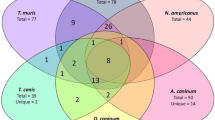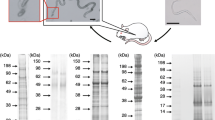Abstract
Ascaris lumbricoides is responsible for a highly disseminated helminth parasitic disease, ascariosis, a relevant parasitosis that responds for great financial burden on the public health system of developing countries. In this work, metabolic fingerprinting using high-resolution mass spectrometry (HRMS) was employed to identify marker molecules from A. lumbricoides in different development stages. We have identified nine biomarkers, such as pheromones and steroidal prohormones in early stages, among other molecules in late development stages, making up four molecules for fertilized eggs, four marker molecules for first larvae (L1) and one marker molecule for third larvae (L3). Therefore, our findings indicate that this approach is suitable for biochemical characterization of A. lumbricoides development stages. Moreover, the straightforward analytical method employed, with almost no sample preparation from a complex matrix (feces) using high-resolution mass spectrometry, suggests that it is possible to seek for an easier and faster way to study animal molding processes.


Similar content being viewed by others
References
Aguinaldo AMA, Turbeville JM, Linford LS, Rivera MC, Garey JR, Raff RA, Lake JA (1997) Evidence for a clade of nematodes, arthropods and other moulting animals. Nature 387:489–493
Araujo P (1972) Observacoes pertinentes as primeiras ecdises de larvas de Ascaris lumbricoides, A. suum e Toxocara canis. Rev Inst Med Trop Sao Paulo 14:89–90
Artigas PT, Ueta MT (1989) Sobre a evoluçäo de Ascaris lumbricoides linnaeus, 1758, na fase larvar endovular. Mem Inst Butantan 51:15–24
Barbara MIHMP, Escoubas LTP (1991) Cuticular Hydrocarbons: Species and Population-Level Discrimination in Termites1 on Current Research on Wood-Destroying Organisms and Future Prospects for Protecting Wood in Use:15
Bethony J, Brooker S, Albonico M, Geiger SM, Loukas A, Diemert D, Hotez PJ (2006) Soil-transmitted helminth infections: ascariasis, trichuriasis, and hookworm. Lancet 367:1521–1532
Blaxter M (1998) Caenorhabditis elegans is a nematode. Science 282:2041–2046
Carlson D, Langley P, Huyton P (1978) Sex pheromone of the tsetse fly: isolation, identification, and synthesis of contact aphrodisiacs. Science 201:750–753
Cutler RG, Thompson KW, Camandola S, Mack KT, Mattson MP (2014) Sphingolipid metabolism regulates development and lifespan in Caenorhabditis elegans. Mech Ageing Dev 143:9–18
De Silva N, Chan M, Bundy D (1997) Morbidity and mortality due to ascariasis: re‐estimation and sensitivity analysis of global numbers at risk. Tropical Med Int Health 2:513–518
Dhanasekaran DN, Reddy EP (2008) JNK signaling in apoptosis. Oncogene 27:6245–6251
Dold C, Holland CV (2011) Ascaris and ascariasis. Microbes Infect 13:632–637
Entchev EV, Kurzchalia TV Requirement of sterols in the life cycle of the nematode Caenorhabditis elegans. In: Seminars in cell & developmental biology, 2005. Elsevier, pp 175-182
Ferreira MS, de Oliveira DN, de Oliveira RN, Allegretti SM, Vercesi AE, Catharino RR (2014) Mass spectrometry imaging: a new vision in differentiating Schistosoma mansoni strains. J Mass Spectrom 49:86–92. doi:10.1002/jms.3308
Ferreira MS, de Oliveira RN, de Oliveira DN, Esteves CZ, Allegretti SM, Catharino RR (2015) Revealing praziquantel molecular targets using mass spectrometry imaging: an expeditious approach applied to Schistosoma mansoni. Int J Parasitol 45:385–391
Geenen P, Bresciani J, Boes J, Pedersen A, Eriksen L, Fagerholm H-P, Nansen P (1999) The morphogenesis of Ascaris suum to the infective third-stage larvae within the egg. J Parasitol 85(4):616–622
Gissendanner CR, Crossgrove K, Kraus KA, Maina CV, Sluder AE (2004) Expression and function of conserved nuclear receptor genes in Caenorhabditis elegans. Dev Biol 266:399–416
Golden JW, Riddle DL (1982) A pheromone influences larval development in the nematode Caenorhabditis elegans. Science 218:578–580
Golden JW, Riddle DL (1984) A pheromone-induced developmental switch in Caenorhabditis elegans: temperature-sensitive mutants reveal a wild-type temperature-dependent process. Proc Natl Acad Sci 81:819–823
Guan XL et al (2013) Biochemical membrane lipidomics during Drosophila development. Dev Cell 24:98–111
Hadley NF (1980) Surface waxes and integumentary permeability: lipids deposited on or associated with the surface of terrestrial plants and animals help protect them from a lethal rate of desiccation. Am Sci 68(5):546–553
Hieb W, Rothstein M (1968) Sterol requirement for reproduction of a free-living nematode. Science 160:778–780
Hoffman W, Poxs J, JA J (1934) Schistosomiasis, due to infestations of Schistosoma man-soni, is not unimportant in certain regions of Puerto Rico, but its distribution and incidence still remain to be definitely determined. The method usually relied upon for diagnosis is that of
Jia K, Albert PS, Riddle DL (2002) DAF-9, a cytochrome P450 regulating C. elegans larval development and adult longevity. Development 129:221–231
Karagiannis-Voules D-A et al (2015) Spatial and temporal distribution of soil-transmitted helminth infection in sub-Saharan Africa: a systematic review and geostatistical meta-analysis. Lancet Infect Dis 15:74–84
Keiser J, Duthaler U, Utzinger J (2010) Update on the diagnosis and treatment of food-borne trematode infections. Curr Opin Infect Dis 23:513–520
Kita K, Hirawake H, Takamiya S (1997) Cytochromes in the respiratory chain of helminth mitochondria. Int J Parasitol 27:617–630
Klun J et al (1980) Sex pheromone chemistry of female corn earworm moth, Heliothis zea. J Chem Ecol 6:165–175
Kühbandner S (2015) Cuticular lipids of the parasitoid Lariophagus distinguendus (Hymenoptera: Pteromalidae): Chemistry and behavioural function.
Kumar A, Byun H-S, Bittman R, Saba JD (2011) The sphingolipid degradation product trans-2-hexadecenal induces cytoskeletal reorganization and apoptosis in a JNK-dependent manner. Cell Signal 23:1144–1152
Ligocka A, Paluszak Z (2009) Effectiveness of different sanitisation technologies on the inactivation of Ascaris suum eggs in organic waste. Bull Vet Inst Pulawy 53:641–644
Lima EO et al (2015) Skin imprinting in silica plates: a potential diagnostic methodology for leprosy using high-resolution mass spectrometry. Anal Chem 87:3585–3592. doi:10.1021/acs.analchem.5b00097
Lin A, Dibling B (2002) The true face of JNK activation in apoptosis. Aging Cell 1:112–116
Matyash V et al. (2004) Sterol-derived hormone (s) controls entry into diapause in Caenorhabditis elegans by consecutive activation of DAF-12 and DAF-16
Niwa R, Niwa YS (2014) Enzymes for ecdysteroid biosynthesis: their biological functions in insects and beyond. Biosci Biotechnol Biochem 78:1283–1292
Olaniran OA, Sudhakar AV, Drijfhout FP, Dublon IA, Hall DR, Hamilton JG, Kirk WD (2013) A male-predominant cuticular hydrocarbon, 7-methyltricosane, is used as a contact pheromone in the western flower thrips Frankliniella occidentalis. J Chem Ecol 39:559–568
Organization WH (1967) Control of ascariasis: report of a WHO expert committee. World Health Organization
Qu Z et al (2015) How did arthropod sesquiterpenoids and ecdysteroids arise? Comparison of hormonal pathway genes in noninsect arthropod genomes. Genome Biol Evol 7:1951–1959
Riddiford LM, Cherbas P, Truman JW (2000) Ecdysone receptors and their biological actions. Vitamins & Hormones 60:1–73
Schlame M, Rua D, Greenberg ML (2000) The biosynthesis and functional role of cardiolipin. Prog Lipid Res 39:257–288
Serra M, Saba JD (2010) Sphingosine 1-phosphate lyase, a key regulator of sphingosine 1-phosphate signaling and function. Adv Enzym Regul 50:349–362
Steiger S, Schmitt T, Schaefer HM (2010) The origin and dynamic evolution of chemical information transfer Proceedings of the Royal Society of London B: Biological Sciences:rspb20102285
Swain R, Behera C, Mridha AR, Gupta SK (2015) Massive hepatobiliary ascariasis at autopsy. BMJ case reports 2015:bcr2015209839
Takamiya S, Kita K, Wang H, Weinstein PP, Hiraishi A, Oya H, Aoki T (1993) Developmental changes in the respiratory chain of Ascaris mitochondria. Biochimica et Biophysica Acta (BBA)-Bioenergetics 1141:65–74
Taren D et al (1987) Contributions of ascariasis to poor nutritional status in children from Chiriqui Province, Republic of Panama. Parasitology 95:603–613
Wang L, Wang T, Fehr WR (2006) Effect of seed development stage on sphingolipid and phospholipid contents in soybean seeds. J Agric Food Chem 54:7812–7816
Watkins SM, Carter LC, German JB (1998) Docosahexaenoic acid accumulates in cardiolipin and enhances HT-29 cell oxidant production. J Lipid Res 39:1583–1588
Yamaoka-Koseki S, Urade R, Kito M (1991) Cardiolipins from rats fed different dietary lipids affect bovine heart cytochrome c oxidase activity. J Nutr 121:956–958
Acknowledgments
INNOVARE Biomarkers Laboratory would like to thank the Coordination for the Improvement of Higher Level (CAPES), the University of Campinas (Unicamp) and São Paulo Research Foundation (FAPESP, Process Nos. 11/50400-0, 14/00084-2, 14/00302-0 and 15/06809-1).
Author information
Authors and Affiliations
Corresponding authors
Ethics declarations
Conflict of interest
The authors declare that they have no conflict of interest.
Research involving human participants
This study obtained the approval of the Ethics Review Board of the State University of Ponta Grossa (Protocol 501171), and all experiments were performed according to the Board’s guidelines.
Informed consent
Informed consent was obtained from all individual participants included in the study.
Rights and permissions
About this article
Cite this article
Melo, C.F.O.R., Esteves, C.Z., de Oliveira, R.N. et al. Early developmental stages of Ascaris lumbricoides featured by high-resolution mass spectrometry. Parasitol Res 115, 4107–4114 (2016). https://doi.org/10.1007/s00436-016-5183-2
Received:
Accepted:
Published:
Issue Date:
DOI: https://doi.org/10.1007/s00436-016-5183-2




